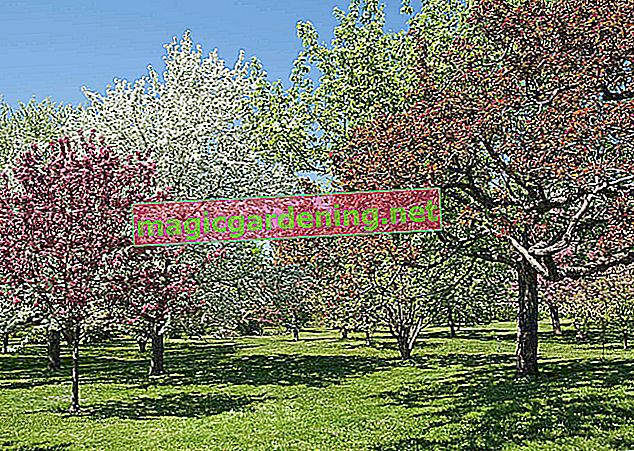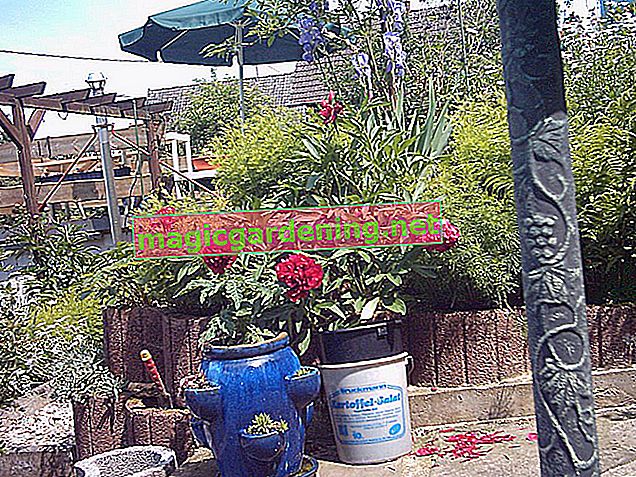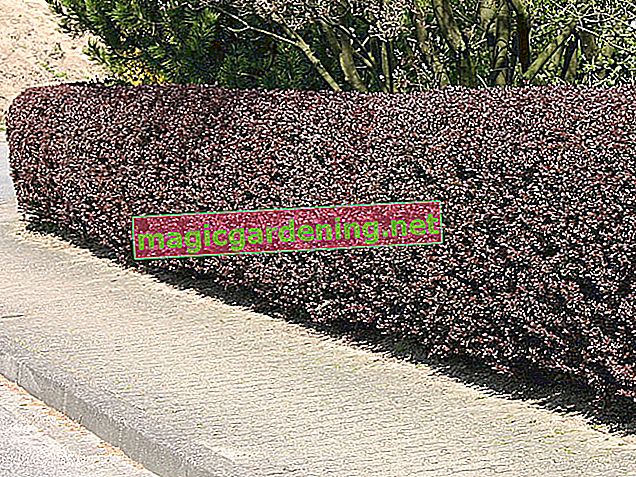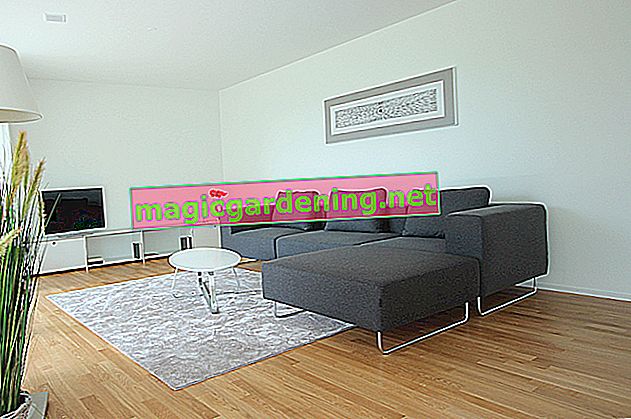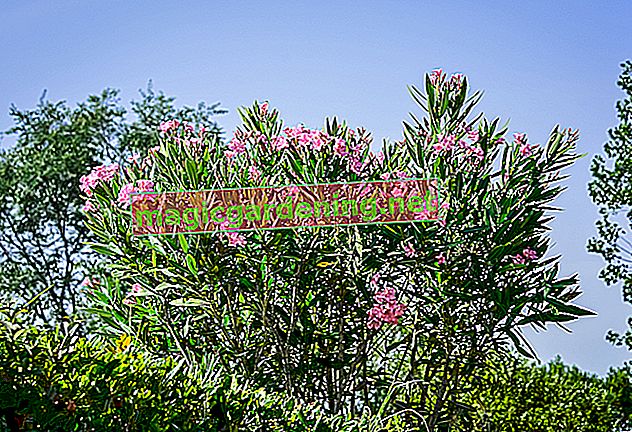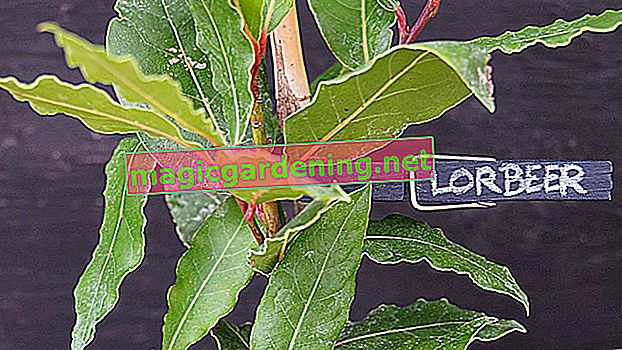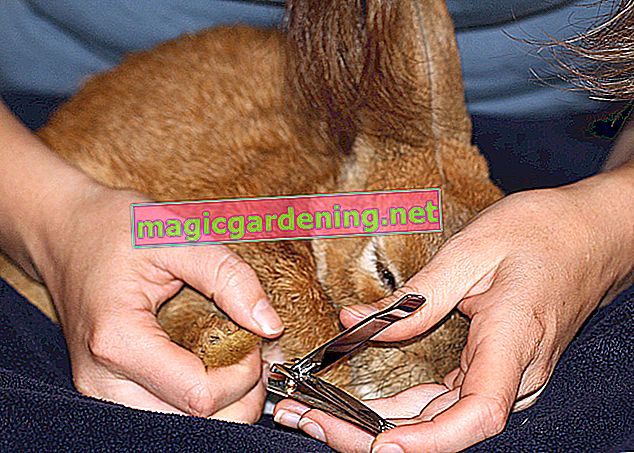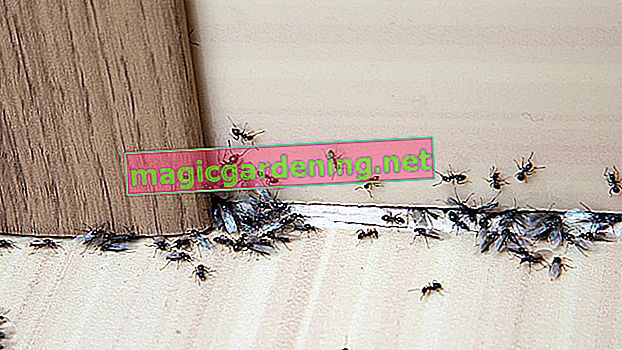
the essentials in brief
- There are many different species of ants that can be found in the house
- Home remedies such as fresh herbs, essential oils or copper can drive ants away
- Sweets and leftovers attract ants
- Relocating ants is not difficult and a non-toxic and non-violent alternative to control
Identify species found in the house
YoutubeIt is extremely important that you identify the species of ant before you begin any control measures. This will give you important information about the way the various types of ants live. You can more easily assess whether the insects really settle in walls, basements and niches, or whether they have just strayed into the house. Not all ants prefer to be close to humans.
also read
- Help, I have ants in the bed!
- Help - ants have settled in my flower pot
- What are ants doing on peonies?
| genus | size | particularities | |
|---|---|---|---|
| Garden ants | Lasius | little ants | make hardly any demands on the living space |
| Wood ants | Formica | approx. 10 mm long | Omnivores, usually build earth nests |
| Horse or giant ants | Camponotus | large ants, up to 18 mm long | colonize damp timber |
| Garden or knot ants | Myrmica | medium-sized ants, about 5 mm | build underground nests or colonize dead wood |
Brown ants

The red garden ant has a reddish brown color and is one of the most widespread species in Central Europe. It inhabits very different habitats and can be found in meadows, gardens, forests and bushland. Here it nests in dead wood, under moss cushions and stones or in the open field and feeds on honeydew. Other brown-colored species are often possible ants in the house.
Brown garden ant (Lasius brunneus)
This species has many names and is also known as the brown wood ant. It is strikingly two-tone and has different shades of brown. While the head and abdomen are dark brown in color, the body, stalks and extremities appear brownish-gray or yellowish-brown and sometimes slightly reddish.
Risk of confusion:
- Red garden ant (Myrmica rubra)
- Two-colored garden ant or red-backed house ant (Lasius emarginatus)
The species is bound to trees. It colonizes rotten dead wood in light forests, old trees in orchards and in gardens or parks. Here it feeds on the honeydew of the aphids. Stored or built-in wood, which is located near deciduous trees, is also gladly settled. The ants find optimal living conditions in damp construction timber, plasterboard and thermal insulation panels. Therefore, Lasius brunneus is the most frequently reported pest ant in Germany.
Black ants
Species from different genera fall into this group and are more difficult to identify. Therefore not only the color but also the habitat should be examined more closely. The demands on the environmental conditions are very different depending on the species.
Black garden ant (Lasius niger)

The species is not your typical house ant. It builds its nests in moderately dry habitats and prefers cavities under stones and in the lawn to raise its heat-needing brood. If the weather becomes suboptimal, it looks for sheltered areas and can appear in crevices in the wall. They can penetrate houses through insulation material if there is a direct connection between the insulation layer and the nest. Reports of nests under sheet metal roof structures are rare.
Typical of the species is a thick body hair, which, depending on the incidence of light, shines to different degrees of silver. Fighting the dark brown to black colored ants is usually pointless. After a colony has been exterminated, the next colony settles in the favorable nesting opportunities of its predecessors.
Black horse ant (Camponotus herculeanus)
This black colored species has dark red legs and scales. Your body looks stocky because of the short extremities. The ant prefers shady and moist soils in forests. It is often found in mountain spruce forests, but can also be observed in open terrain and in lowlands. The insects colonize wood through external damage or through the roots.
This is where the ant builds its nests:
- mainly in the wood of healthy trees
- prefers spruce, occasionally pine, rarely hardwood
- Nests sometimes extend into the ground
- only colonizes built-up wood with direct contact with the ground
Glossy black wood ant (Lasius fuliginosus)

This species is characterized by a deep black colored body, the color of which shines conspicuously in the light. The mouthparts and antennae are brownish in color. The wood ant prefers to build its nests in dead wood. It also settles in fence posts or roof beams of buildings, although modern houses are rarely damaged by this species.
The workers build a so-called cardboard nest in the wood, which consists of chewed wood, sugar and other solids. This creates a blackish mass, which is filled into the self-gnawed cavities. The cardboard nest forms the growth basis for the fungus Cladosporium myrmecophilum. Its fine network of roots penetrates the thin walls and strengthens the nest in this way.
Yellow ants

Light colored ants such as yellow meadow ant or yellow thief ant live underground in the substrate of various landscapes. While the former feeds on the honeydew of the root lice, the thief ant uses related species. This mini ant steals prey, eggs, larvae and pupae from the host animals. Neither species target human habitation.
Pharaoh ant (Monomorium pharaonis)
The workers of this tiny ant grow to be about two millimeters long and amber yellow in color with a dark tip of the abdomen. The chest and abdomen are connected by a stalk on which two conspicuous humps are formed. Male insects are black in color and slightly larger. The queen reaches a size of up to 4.5 millimeters and appears a little darker than the workers. The species was introduced from Asia and has developed into a worldwide cultural successor.
Pharaoh ants live here:
- in buildings with consistently high temperatures
- heated greenhouses, commercial kitchens and bakeries
- after introduction into private households
The species is not only active in summer but year-round and does not survive winter outdoors. It is an omnivore that prefers to eat foods that contain protein and sugar. Insects are a problem in hospitals because they are attracted by blood and pus and can transmit disease. Control is difficult because the nests are hidden. Food poisons with a long latency period promise the greatest success, because they are carried into the nest and fed to the brood and queen.
Two to multicolored ants
The division into single or multi-colored types is not always clearly possible. If you can't find your species in this category, check out the solid color species. Different color casts and characteristics are also possible within a species.
Brown and black horse ant (Camponotus ligniperdus)

This species is characterized by a shiny body. The head and most of the abdomen are black in color, while the anterior abdominal segment, stalks and legs have a red-brown glow. The horse ant prefers significantly warmer locations than the related black horse ant. It inhabits dry and sunny deciduous and mixed forests. Occasionally it can be found on dry, bushy grassland and on fields.
Nest building:
- preferably in soft dead wood
- Tree trunks up to three meters high and close to the ground
- pure earth nests are possible
- does not colonize living wood
Occasionally the species is viewed as a house ant. If it occurs in close proximity to human settlements, it can also occur in buildings. It nests in built-up wood of houses, sheds or bridges and builds nests in fence posts.
Two-colored garden ant (Lasius emarginatus)
The species is regarded as a typical house and garden ant, whereby the heat-loving ant is often confused with Larius brunneus. It is also known as the red-backed house ant, because the breast is red-yellow to red-brown in color. The head and abdomen are dark brown in color and stand out clearly from the chest.
The heat-loving species occurs predominantly in southern parts of Germany. It builds its nests in cracks in the rock, under stones and in rotten dead wood. Since the ants prefer rock habitats, settlement areas sealed with concrete and stones also appear extremely attractive. They can nest in house walls and crevices or in the beams if these nesting sites have already been damaged by insects and fungi.
Flying ants
Winged ants are not a species of their own. In an ant colony there are workers, queens and males. While in some species only males are winged, there are few kin groups with winged queens. The formation of the wings has an evolutionary background. This enables the insects to reach mating partners outside of their colony.
If you observe ants with wings crawling out of a niche, this does not yet indicate active reproduction in the house. The males look for partners from other races in order to complete their nuptial flight.
What really helps against ants?
If you want to get rid of ants, you should get rid of the causes of the infestation. It is not enough to distribute home remedies on the ant trails. Such measures provide a short-term remedy, but after a short time the insects can no longer be impressed or look for alternative ways into the house. Put your focus on the nest.

Mourn
If you want to drive ants away, you must follow the ant route to its end. Here is the nest. The ants living in it do not like disturbance and will protect their brood if the nest is affected by intense smells. Therefore, herbs such as chervil, lavender or thyme are ideally suited for keeping people away. Vinegar also contributes to the insects' sense of direction being disturbed. When the aromas are gone, the effect is gone. Therefore, you should bring fresh herbs, vinegar or tea tree oil directly into the nests every day.
Tips
Coins or building materials made of copper are hardly successful in combating ants. Only biocides containing copper are effective, but they can seriously damage bodies of water and other living beings.
YoutubeAttract
There are several ways in which you can attract the insects. You can fill this with toxic substances. Baits develop their attractiveness best in spring, before the plants sprout and leaves or roots are attacked by lice. By this time ants are already foraging for food and willingly accept sweet liquids and attractants. Later in the year, the insects continue to use the building as a nesting place if they have already settled here. They then prefer to look for food outside.
Suitable baits:
- Liver sausage
- tuna
- Sugar water
- Beer and liquor

Remove
Glue traps are only conditionally suitable for fighting, because they cannot catch all ants. Natural home remedies such as baking soda are also not suitable. For baking soda to work, you have to dust the ants thickly with the raising agent. If the insects ingest the smallest particles by cleaning, they die. Baking soda changes the pH value and does not burst, as is often assumed. This method is quite effective for isolated ants in the house.
Relocate
The flower pot trick is of little help with ants that have settled in the house. A clay pot filled with nesting material is accepted if the actual nest is in danger or has been disturbed. To do this, the pot must be placed directly above the nest so that the ants can carry their brood into the new housing. This is difficult to do when ants have settled in the walls. Therefore such relocation attempts are only successful with species that have built a nest in the lawn.
Poison
If there is a massive ants infestation, only poison can effectively fight the plague and destroy all ants. You should generally refrain from using sprays, as this will spread the toxic ingredients into the room air. Food poisons which are applied as a powder and eaten by the ants are more suitable. Fipronil has proven to be an effective agent. The biocide has a long latency period, so that the queens living in the nest and the brood are also poisoned.
Avoid reintroduction after successful control
Individual ants are not yet a problem. Once the insects have settled in the whole house, the damage caused by ants in the house can assume considerable proportions. Identifying nests is the first thing you should do. Possible damage must be repaired, because after an extermination, a new settlement in the existing nesting sites is very likely.
If you want to get rid of the ants permanently and effectively control them, you should replace damaged insulation and joists and renovate walls. In this way you deprive the ants of an important livelihood and scent traces are removed. This is the only way to ensure that no new colonies migrate from outside.
Why do ants come into the house?

Ant species populate different habitats in nature. These include cavities under stones, holes in the earth or rotten wood. Many buildings are designed in such a way that the building materials resemble natural nesting sites. Therefore it happens that ants settle in cracks in the facade, under terrace slabs or in the built-in wood. When the insects follow ant trails in the house and apartment, they are in search of food. They come into the interior through leaky windows and doors or other crevices through the facade. Ants can appear in the house all year round.
Preferred food:
- Sweets
- Meat and cheese
- Fruit and bread
Digression
The ant algorithm
When an ant encounters a new source of food, it ingests food and crawls back to its burrow. On the way back, the insect sprays pheromones to mark the way. Once at home, it chokes out parts of the food to stimulate the roommates. These set off and follow the scent trail. They also put numerous fragrances on the way home so that it smells even stronger.First, the ants find their way to the food source using the scent marks available. Since these still have a weak smell, other ants also get to food via other paths. The insects that have found the shortest route will return to the nest more quickly. The pheromone concentration is now highest on the shorter path, which is why the following insects prefer this path. An ant road has emerged.
Ants are not the primary wood destroyers
The insects are not considered to be wood destroyers in the narrower sense, because they cannot use the fibers as food. Some species that specialize in deadwood only use it as a nesting substrate and colonize cavities and passages created by wood-decomposing fungi and insect pests. If they settle in built-in wood, then they prefer to use dilapidated and damaged wooden components. The different degrees of hardness of the wood are used effectively. Early wood parts can easily be cleared out, while the late wood remains as walls between the chambers.
Stray ants

Occasionally it happens that ants build nests in the flower pot on the house. The colony can be transported into the house unnoticed if the bucket is brought to the basement for winter. Therefore, you should carefully check the substrate. If ants have settled, you can combat them effectively with water. In the immersion bath, the corridors are rinsed so that the ants and their brood flee.
If ants settle in the wood
Direct destruction of wood-based materials by ants is still possible, although the ants are not primarily targeting buildings and intact wood. Often the building materials for the insects offer completely innovative nesting possibilities with optimal conditions for brood rearing. Thermal composite systems moistened with splash water are an ideal nesting substrate. They ensure a perfect climate, which is similar to the conditions in dead wood.
Ants are influenced by progressive developments. They move with the times and use new nesting opportunities in insulated facades.
Evidence of ant nests
The search for circumstantial evidence provides quick information on whether an ant nest is likely in the house or apartment. Ants do not appear for no reason. You need optimal living conditions near the house and you have to find your way in first. These clues increase the likelihood that an ant colony has settled in the house. Despite the affirmation of these aspects, it can happen that individual ants only get lost in the kitchen and bathroom.
Where ant nests are likely
- Facade insulation : base area with ground contact and overgrown by dense vegetation
- Half-timbered house : surrounded by a densely planted vegetable garden
- Partitions : pre-damaged in wet baths and cool bedrooms, beamed by fungi and insects
Tips
The Deutsche Ameisenschutzwarte eV has numerous regional associations in which volunteer ant experts provide their help.
Check house and apartment
If you regularly come across small heaps of flour made from sawdust, mortar or insulation material while cleaning, an infestation by insects is likely. This assumption is supported if you find remains of insect bodies in the piles. Dead ants on the ground, however, do not have to indicate a pest infestation.
If the building is built partially or entirely from wooden beams, it offers ants potential nesting opportunities. These nesting sites are even more attractive the more humid they are. Ant nests therefore often occur near sources of moisture such as bathrooms, kitchens or winter gardens, where the building structure has a higher level of moisture in the wood.
Check the environment
In order for ants to find their way into your house, they must already find good living conditions in the area. An adjacent forest, dense vegetation directly on the house facade or a garden can be used as indicators. There must be a direct connection between the house and the garden that appears attractive to ants.
frequently asked Questions
Where do ants come from in the house?

If you suddenly find ants in the house, it could be for a number of reasons. Ant colonies often migrate from the outside and settle in ready-made nesting facilities. This is the case when an old tree is felled or a shed is torn down nearby. You can find these places above the scent trails of old ant trails or are attracted by sweet scents.
A new colony establishment by a queen in the house is rather unlikely. Ants may well accumulate in the house after rain. Often it is an earth-dwelling species that nest in direct connection with the house. If the nest is flooded, the insects try to save their brood in the dry.
How can I avoid ants in the house?
If ants become a nuisance in the house and garden every year, simple tips will help. To prevent the ants from entering the building, all entry gates should be closed. This includes not only visible gaps under windows and doors but also underground cracks on the facade. Here, ants living in the ground can easily get into the insulation. Strips with contact poisons can be applied where no sealing is possible.
Is it worth pest control by exterminators?
When choosing a pest controller, be sure to find out exactly how to do it. A professional exterminator will have knowledge of the species and will identify the species before taking action. With this information he can assess whether the ants could actually have settled in the house. Experts check the rooms for possible traces and seal entry gates. Randomly applied gels or long-term remedies usually do not promise any success.
What do ants feed on in the house?
The food spectrum of the ants is broad. Many species feed on honeydew, while other ants are omnivorous. In the house they target sugary and protein-rich foods. They eat fruit, meat and cheese or breadcrumbs.

